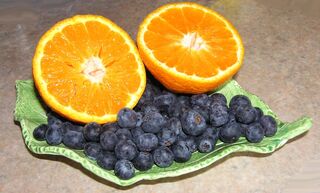Flow
Eating Fruit Might Help with Erectile Dysfunction
Food that improves blood flow might boost bedroom confidence.
Posted January 15, 2021 Reviewed by Abigail Fagan

Men may have another reason to eat well.
If a man has had problems with his erections, he may get anxious during the next attempts. No one wants to be disappointed or disappoint his partner.
But it's important to know that anxiety sometimes isn't the source of the problem, or at least the original source. Erectile dysfunction (ED) is often a sign of poor blood flow. ED, which increases with age, is a warning sign that you may be at risk of heart disease or a stroke. High-blood pressure, obesity and smoking increase your risk of both ED and cardiovascular disease. ED is considered its own risk factor for cardiovascular problems, even if you don't have the other issues.
And just as with heart disease, your diet can make a difference. Don't focus on one "miracle food";l always aim for a diet with a variety of recommended foods. Each will contain different nutrients you need. One simple rule to follow: Eat food with bright natural colors.
To potentially mitigate the risk of ED, eat at least three servings a week of any of the following foods—strawberries, blueberries, red wine, apples, pears, and citrus products. So you could have strawberries one day, citrus the next, and blueberries on the third day. This could cut a man's risk of ED by 19 percent, according to a study of more than 25,000 men published in the American Journal of Clinical Nutrition. In this research, the dietary benefits were strongest in younger men who were also overweight.
How the study worked: Over about 10 years, the researchers asked volunteers about their diet and other key questions, including their ability to have and maintain an erection during intercourse. More than 35 percent had a problem at some point. But men who ate food high in flavonoids, also called antioxidants, had fewer erection issues. That’s probably because flavonoids increase blood flow, improving blood pressure and helping to open blood vessels while making your arteries more flexible.
There are six kinds of flavonoids. The ED study found foods rich in three—anthocyanins, flavones, and flavanones—especially helpful, with blueberries and citrus fruit at the top. Men who got at least five hours a week of exercise and consumed flavonoid-rich foods had the lowest ED risk.
So which foods could help you or your man?
Blueberries. These berries contain all six of the flavonoids. Put them in your oatmeal for a fiber-rich breakfast or eat them for dessert. The anthocyanins in blueberries may improve markers of heart disease. Blueberries also may help you burn off fat.
Like red wine, blueberries are a good source of resveratrol, a flavonol, another type among the six flavonoids.
Some research links resveratrol to lower levels of inflammation and blood clotting—although it still isn’t clear that it prevents heart disease.
Other berries. Blackberries, cherries, and raspberries also offer all six flavonoids. Strawberries have some anthocyanins.
Grapes or red wine. Grapes and red wine are a good source of anthocyanins.
Why is red wine considered more beneficial than white? The answer: the nutrients, including resveratrol, in wine are concentrated in grape skin, and vintners remove the skin to make white wine earlier in the process. There is some evidence that having a bit less than one glass of wine a day may help protect you against heart disease. But you may be able to get the same effects from grapes or grape juice. If alcohol has ever been a problem for you, opt for the grapes.
Citrus fruits. Oranges, grapefruit, tangerines, lemons, and limes contain flavanones, one of the six flavonoids the ED study found especially helpful.
Apples and pears. It may very well be true that an apple a day keeps the doctor away. Apples may help you burn fat for the same reasons blueberries do. Like apples, pears are full of flavonoids and other nutrients and high in fiber.
Don’t peel off the skin—it contains the most flavonoids. The darker redder or bluer apples contain more flavonoids than yellow or green ones.
Hot peppers. To get your flavones, eat celery, parsley, various herbs and hot peppers.
Note that a chicken parm hero or double cheeseburger or beef stroganoff with buttered noodles isn't on this list...
A version of this story also appears on Your Care Everywhere.




